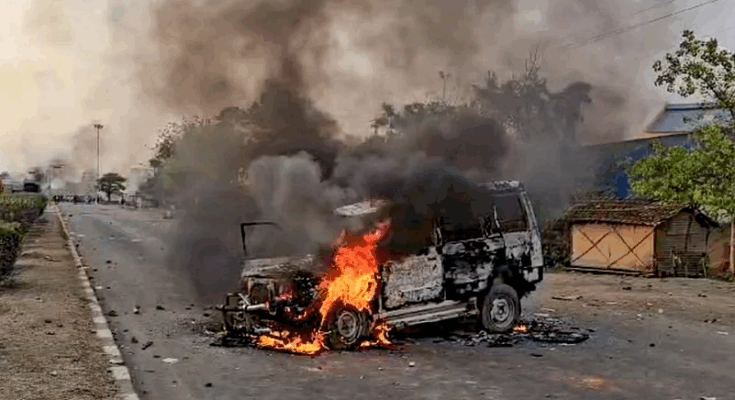The districts of Murshidabad and Malda in Bengal have been tense for the past two weeks. Internet services are suspended. Religious polarization is increasing on TV and social media. Rumors are spreading. This fact-finding mission was about finding out what actually happened.
Where did we go? Why did we go?
On April 18 and 19, a 17-member fact-finding team comprising Feminists in Resistance (FIR), Association for Protection of Democratic Rights (APDR), Nari Chetna, Committee for the Release of Political Prisoners (CRPP), and Gono Songram Moncho (Murshidabad) visited several ‘riot’-affected areas around the Shamsherganj block in Murshidabad. We spoke with victims, eyewitnesses, residents of nearby areas, and representatives from the police and administration to make sense of the recent happenings.
Starting from Dak Bungalow More in Dhuliyan, we visited Ranipur, Dighri, Paharghati, Betbona, Lalpur Singhpara, Shiv Mandir Bazaar, Dhulian Municipality, Hijaltola, Kanchantala Kamat, Jafrabad, Hausnagar, and Shamsherganj police station. The next day, we visited a government relief camp at Parlalpur High School in Baishnabnagar, Malda. However, we were stopped at the main gate by police and BSF personnel and were unable to speak to the people in the camp.
Over the course of these two days, the testimonials we heard, the scenes we witnessed, and our own experiences, enabled us to piece together a narrative of what really happened, and what how this atmosphere of violence was manufactured. Today, we present our findings, the narrative that emerged, and our observations, questions, and concerns regarding the situation.
What happened?
On Friday, April 11, there were protest rallies against the Waqf Amendment in various parts of Dhuliyan. As one such rally reached Ghoshpara near Dhulian Sanghati Udyan, stones were pelted at the protesters from three neighboring houses. The rally scattered; some were injured. Enraged by the sudden attack, a crowd began vandalizing nearby shops— a well known sweet shop, ‘Janapriya Mistanna Bhandar’, owned by a Hindu, and a garment store owned by a Muslim. As tyres were set on fire, the sweet shop also caught fire. All of this happened just a few minutes away from Shamsherganj police station, yet the police turned a blind eye.
An eyewitness shared that among the three houses from which the stones were pelted belonged to someone associated with a Hindutva organization, who had recently circulated a video inciting threats. The other two were owned by his followers.
The sweet shop owner said despite reporting the vandalism, the police did nothing. The next day, he and his staff were slapped by BSF personnel when they tried to shut their shop. Since the shutter remained open, the shop was looted again on the second day. The administration remained indifferent.
On the same day, the peaceful protest at Dak Bungalow More ended in violence when masked individuals attacked ‘Srihari Hindu Hotel’ and set it on fire. They also tried to attack another sweet shop, but Muslim shopkeepers in the area stopped them and protected the Hindu-owned shop.
The failure of the administration to control Friday’s violence fueled the spread of rumors, breaking the long-standing peaceful coexistence between communities and sowing mistrust.
In Hausnagar, from 8 PM till 3–4 AM, masked individuals dressed as police and BSF personnel raided homes in Muslim localities, picking up young men aged 17–30 without any warrants or explanations. Among those detained were Nazmi Alam (17), Tahir Sheikh (26), Tajamul Haque (25), Netajul Haque (23), Firoz Ali (21), Habibur Rahman (30), Habib Sheikh (35), Samir Sheikh (32), and Shahid Jamal (26), all of whom were working-class people.
Local residents claimed these ‘police’ carried knives, daggers, and hammers. There were reports of these ‘police’ breaking down doors and windows to abduct people. Families had no news of the detainees for two days until they were informed by the local Panchayat head that the men were held in Jangipur jail. Amongst them Netajul Haque was taken on remand to Raghunathganj Police Station. When the families visited the men in jail, they observed that most of them were beaten severely in custody.
Similar arrests occurred in Hijaltola where four people were picked up. Locals estimate around 274 people were detained from that entire area..
On Saturday morning, 9am, more violence erupted. A Muslim shop was burned in Shiv Mandir Bazaar. Attacks also occurred in Betbona and Jafrabad.
Victims in Betbona reported that around 1,000 masked individuals looted and burned their homes. Women were harassed, given rape threats. Important documents, school books, lifelong savings, livestock—everything was destroyed. About 150 families were affected. Despite repeated calls, the police didn’t respond. Some even accused the local councilor of inciting the violence.
Many fled across the river to Malda to save themselves.
Even though the attackers were masked and the survivors were unsure of their identities, articulating them rather as miscreants, FIRs filed at the police station labeled them as “Muslim terrorists.” Victims claimed the attackers carried bombs and swords.
Similar attacks occurred in Jafrabad, where Hargobindo Das and Chandan Das were hacked to death. Residents stated that the violence lasted 3–4 hours, but it took five hours for the police to arrive—despite the scene being only eight minutes away from the station. The attackers looted, set houses on fire. Here too, the attacks were targeted. About 250–300 masked people were involved in the attack. However, despite the attackers being masked, some of the survivors claim that they were Muslims from nearby villagers. While everyone shared that they have all been living in harmony for generations, the attacks have shaken their trust in their neighbours. When asked, if such incidents have happened before and if not, then why do they think it happened now, some stated that it was perhaps the Waqf protests that stirred this unrest, despite there being no evidence of the same.
On Saturday night, a local market, Shibmandir bazaar, jointly founded by Hindus and Muslims around 45 years back, was attacked around 10pm-12am. Muslim shops were set on fire in the fish market, vegetable market. Fruit shops, grocery shops too were arsoned. Manjur Rahman, Omar Farooq, FulChand Mandal’s shops were all set on fire setting ablaze to products amounting to 20-25 lakhs. When our factfinding team reached the spot, there were still embers sparking in one of the shops. There were rumours of attack on the nearby mosque.
In Sajur More under Suti police station, there was a roadblock on the National Highway-12 due to the Waqf protest and Eijaj Ahmed, a resident of Kasimnagar was killed as police openfired. In Tarbagan too, there were clashes and a 12-year-old boy, Hasan Sheikh, and two others were injured by gunfire. Hasan had to have a kidney removed and his pancreas is severely damaged. The injured are all admitted in Behrampur Hospital and are in critical conditions. Out of fear of the BSF, families didn’t even file FIRs.
Yet, despite the failure of police and administration, in many places, locals from both communities formed volunteer teams and guarded temples and mosques together, showing that communal harmony still has a chance. In Maheshpur, Dighri Paharghanti, Lalpur Singhpara residents formed committees to stay vigil and prevent the entry of outsiders. People from both communities want peace to be restored.
Our observations: Some Questions and Concerns
1. The ‘riots’ weren’t spontaneous, nor was this communal tension created in a day —they were systematically orchestrated, organized. The attacks were all targeted. Houses and shops, whether Hindu or Muslim, were set to fire neatly such that while one burnt to pieces, the neighbouring buildings showed no trace of it. The fake BSF raids targeted only Muslim villages, while the attack and arson happened only in two Hindu areas.
Interestingly, areas with a mixed population remained peaceful. In Ward 11, Kamat, even though all residents were Muslim, four Hindu shops and a temple remained untouched. Again, while there was peace in Paharghanti, just about 200 metres away, Betbona was attacked. While the survivors of Betbona, Ranipur and Jafrabad stated that the miscreants were masked, their narratives brought to surface old wounds of partition, of Hindus being under attack. One of the victims in Jafrabad shared, some attackers wore half-pants. While the victims spoke of incidents of attackers raising religious slogans and threatened the victims, they were unable to share much identifiable specifics of these incidents.
As our factfinding team continued its mission, there were phonecalls being made to relay whatever was being discussed to some outsiders. Often people claiming to be Panchayat officebearers stopped us to ask if we had permissions. We were often being photographed, videographed. In Jafrabad as we were speaking to the family of the victims who were killed, a local leader, who some later stated was associated with some Hindutva organization, threatened us and asked residents to be careful while speaking to us.
2. The unrest was a clear failure of law and order. Police, administration could have prevented it, if they wanted. Their indifference and inaction allowed this violence to spread, fanning communal unrest.
Meanwhile, police atrocities created an atmosphere of fear in Muslim villages. Despite the area being sensitive, and there being tensions before – with their being small-scale incidents of unrest during NRC, Nupur Sharma incident, and recent incidents in Mathabota, the police took no other step to maintain peace other than suspending internet services. There was no peace process initiated. No meetings held with people from both communities to prevent such incidents. Furthermore, despite the turmoil of 11th April in Sanhati Udyan, the police took no preventive action to maintain peace. Despite the unrest in Dakbunglow more, there were no police pickets arranged anywhere. Even now, the administration has done nothing to support the victims of Betbona. There have been no attempts to compensate the victims, no efforts made to rehabilitate the homeless. This administrative inaction has further worked to facilitate the political gameplan of those seeking to polarise people. When the factfinding team went to speak to the Officer-in-Charge of Samserganj Police station, we were unable to meet with him despite waiting for a long time. The officer who was second in command, listened to our questions but was unable to respond to them.
The next day, when we went to the relief camp at Parlalanpur High School, we were not allowed to enter. We were told by police and BSF personnel that entry was prohibited without the District Magistrate’s permission. When we asked to see this order, they were unable to produce it. Later, SDPI’s Faizal Reza showed a High Court order, which we later verified, was specifically about a particular organization’s relief distribution, and not applicable to us at all.
This raises serious questions—what are they hiding by turning that camp into a prison-like space? In doing so, are they not creating more room for rumors and misinformation?
Even after speaking to the local MLA of the Shiv Mandir area, we did not receive any clear answers. He brushed it off as the work of “outsiders” and said he would arrange for tarpaulin sheets for the victims—as if that settled everything.
3. Misinformation and rumors played a huge role in intensifying religious polarization. Some media outlets contributed to this by airing rumours as news without bothering to verify. Many places we visited hadn’t seen any reporters before us.
4. People from both communities are terrified. There is deep mistrust. Hindu victims are demanding permanent BSF camps, while Muslims want peace and safety. BSF’s abuses and atrocities also haunt many. In the light of this, we ask is peace possible through fear and force? Why, even after so many days, the administration has failed to earn the trust of people?
5. Communal forces like BJP and RSS are using this tragedy for political gain. The seeds of Islamophobia they’ve sown so long are now being echoed in the voices of victims. Calls for Hindu unity, President’s rule, and permanent BSF camps are being made. The attacks have instilled a deep sense of fear and insecurity amongst the victims. The Hindus are often channelising their fear through aggression, while the Muslims have become all the more vulnerable and terrified.
A woman bidi worker summed it up well:
“Whoever started it, we’re all suffering. They’re scared of us now, and we’re scared of the police. But both sides are losing. They make sesame and sweets—we’re the ones who eat them. The bidi factories are shut. Markets are closed. People are scared to open shops. Everyone’s lost their livelihood. We used to live together peacefully. We did namaz, they did puja. Now everyone is afraid. We just want peace.”
6. If arrests are made without a warrant, according to the Supreme Court’s 1996 D.K. Basu judgment against police brutality, a strict set of procedures need to be followed. These include informing the person being arrested about the reason for arrest, informing their family or friends about the charges, maintaining arrest records, and producing the arrested individual before a magistrate within 24 hours. None of these protocols were followed in the areas we visited. This makes the actions of the police and BSF not just unlawful, but also in direct violation of constitutional rights. Most of the Muslim people arrested complained of custodial torture. Women in the households complained that the ‘police’ entered their houses at night without their consent. There were complaints of harassment. While Hassan Sheikh, Ghias Uddin Sheikh are still in hospital fighting for their lives, why has there been no cases lodged against those who fired the bullets?
In conclusion, we want to emphasize that the situation in Murshidabad and Malda is not just a communal clash or a law and order issue. It is a deeply organized, politically driven situation, where religious polarization, state inaction, and police repression have combined to disturb years of peaceful coexistence. The real victims here are ordinary people – Hindus and Muslims alike, who have lost homes, livelihoods, peace, and trust. So the question remains who organised these attacks? Why were police, administration deliberately inactive? Further questions linger, why did victims from Betbona and Jafrabad have to be rescued by boat by the people from Parlalpur? Why was the factfinding team prevented from visiting the Parlalpur relief camp? Who are these fake BSF personnel raising hell in Muslim neighbourhoods? Why are police kidnapping Muslim youth without arrest warrants or memo?
As a fact-finding team, we demand:
- Immediate and independent judicial investigation into all incidents since April 11.
- The state government must take responsibility to immediately begin peace process in the affected areas and restore normalcy.
- Immediate unconditional release of all illegally detained persons. Action must be taken against officials involved in illegal arrests.
- Affected families must be compensated immediately.
- Those rendered homeless must be immediately rehabilitated.
- Disciplinary action must be taken against police and BSF personnel involved in brutality and negligence.
- The FIRs of the victims of firing must be accepted and investigations must begin into the incident.
- The state must take responsibility for administrative failure to prevent communal tension and immediately begin an inquiry against all officers on duty on those days.
Nisha Biswas (9830555415) and Rangta Munshi (9836110135) on behalf of the joint fact finding team




